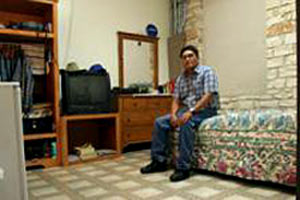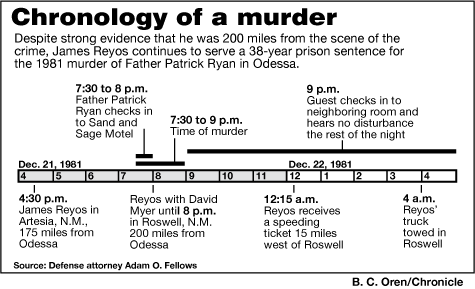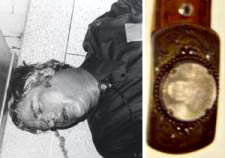A Case Study of Sexual Abuse and Murder
Reyos was arrested, indicted, and tried for murder.
The jury had a defendant who was an Indian and a homosexual and who had confessed (although he almost immediately recanted the confession). They convicted Reyos, but
However, there are other difficulties with the case against Reyos:
The prosecution dismissed all the evidence that Reyos could not have committed the crime as a “handy” alibi.30“Convicted Priest Killer Faces 38-Year Sentence,” Galveston Daly News, June 12, 1983. Reyos was convicted on the basis of his confession and sentenced to 38 years in a maximum security prison.
Cassell’s main point, however, is that “no good rationale is offered as to why the presumptively conscientious jurors found Reyos guilty beyond a reasonable doubt when he was innocent.”31Paul G. Cassell, “The Guilty and the ‘Innocent’: An Examination of Alleged Cases of Wrongful Conviction from False Confessions,” Harvard Journal of Law and Public Policy, Spring 1991. Cassell does not seem to think there is any possibility that a public defender might not mount a sufficiently thorough defense or that a rural Texas jury might be prejudiced against an Indian and a homosexual.
In December 1991 Dennis Cadra, who had been an Ector County prosecutor and had been involved in the appeal in Reyos case,32Bob Banta, “Pleas by Mail Sought for Convict in Priest’s Death, Austin America-Statesman, May 19, 1992. reviewed the trial transcript (which was about to be discarded) and analyzed carefully the evidence for Reyos’ whereabouts. This evidence had not been thoroughly explored or explained at the trial. He decided that Reyos was innocent and wrote to Texas Governor Ann Richards:
Despite my 16 years as a prosecutor, I came to the firm conclusion that it was physically impossible for Mr. Reyos to have committed the crime for which he was convicted and for which he has been in the Texas penitentiary for almost eight years.”33Davis Elliot, “District Attorney: Inmate Is Innocent,” Austin America-Statesman, May 10, 1992
At first no one – the governor, the parole board, the trial officials – would act.34David Elliot, “Reyos Appeal Pending Governor, Board Action,” Austin American-Statesman, May 16, 1992. A prosecutor, J. Anthony Foster, who helped convict Reyos, wrote to the parole board and dismissed Cadra’s analysis as “Monday morning quarterbacking.”35Ginny O’Carroll, “True Confessions – Or False?” Newsweek, September 13, 1993. The parole board voted unanimously in 1992 to deny a pardon for Reyos.36David Elliott, “Board Votes to Oppose Pardon in Reyos Case,” Austin American-Statesman, July 8, 1992. Without the recommendation of the parole board, the governor of Texas cannot pardon an inmate.
On 1993 the Odessa police, in violation of official policy, destroyed all physical evidence of the murder.37Jordan Smith, “Who Killed Father Ryan?” Austin Chronicle, June 17, 2005. Therefore modern DNA testing cannot be used to establish Reyos’ guilt or innocence.
In 1995 Reyos was paroled, but was arrested for drunk driving and returned to prison.38Jim Henderson, “‘I Didn’t Do This,’” Houston Chronicle, December 17, 2001. In 2004 he was released early for good behavior. He goes to Alcoholics Anonymous and his parole officer. His movements are monitored by an electronic bracelet, and he cannot leave his room at nights or weekends. Bishop Matthiesen is now convinced that Reyos is innocent and, along with many others, has asked the governor of Texas to pardon Reyos.39Davis Elliott, “Inmate Is Innocent,” Austin American-Statesman, May 10, 1992.

Possible Scenario of the Murder
Ryan almost certainly came to the United States as a guest of the Servants of the Paraclete in Jemez Springs and was there because of sexual misconduct. He was pronounced “cured,” like other abusers, and Matthiesen accepted him as he did other abusers.
All records at the Jemez Springs facility have been destroyed by the Servants of the Paraclete40Robert Patrick, “Records in Priest Sex Cases Were Destroyed,” St. Louis Post-Dispatch, October 17, 2005.; therefore we do not know whom Ryan could have met if and when he was at Jemez Springs. The real killer of the Rev. Patrick Ryan remains unidentified. The failure of Bishop Matthiesen and the Pallotines to be forthcoming at the time of the murder and the trial about Ryan’s background and contacts helped put an innocent man in jail for decades.
On the afternoon of December 21, 1981 Ryan expected to be home for dinner and started cooking his own dinner. He got an unexpected call. It was urgent enough that he turned off the stove and, without putting the food into the refrigerator, got into his car and drove to Odessa, possibly stopping in Hobbs to pick up the person who called. (As Ryan and Reyos had already had sex in Ryan’s rectory the night before, there would seem to be little point in their driving an hour and a half to Odessa if they wanted to have sex again.) Ryan and the caller went to Odessa or met in Odessa, which is on Interstate 20 and far enough from Denver City that neither Ryan nor the other man (who may have been from Hobbs) would be recognized. Ryan checked into the motel anonymously.
The person who called Ryan was either personally known to Ryan or was referred to him by someone Ryan knew. The purpose of the meeting was to have sex, which Ryan and the other man immediately did.
The other man was overcome with anger after sex. He had probably not met with Ryan to murder him; he had not brought a knife or gun. He assaulted Ryan violently, subdued him, and tied Ryan’s hands together with an improvised rope (a sock, in one version; a pillow case, in another). He then beat Ryan so hard that Ryan’s heart stopped. The fight during which he subdued Ryan must have been loud, as the wreckage of the motel room evidenced. The other man did not know whether there were people in adjacent rooms who might hear – further indication that the murder was not planned.
The killer than left the motel and drove Ryan’s car to Hobbs, where he may have lived or may have left his car. He took two of Ryan’s personal items, the chalice and the accordion, but left the money. He drove away.
A possible explanation of the other man’s murderous anger was that he was a victim of sexual abuse by either Ryan or by another priest whom Ryan had met at Jemez Springs and who referred him to Ryan.
Postscript A Suicide by Cyanide at a Confessional
On December 4, 1982, a year after the murder and three weeks after Reyos was arrested for the murder, a sun-tanned man walked into Sacred Heart Church in Boise, Idaho for confession. While waiting to go to confession, the man swallowed a cyanide capsule and died.41Jordan Smith, “Who Killed Father Ryan,” Austin Chronicle, June 17, 2005.
All that he had in his pockets was $1,900 in cash and a note saying that the money should be used for his burial and the rest donated to the church. It was signed Wm L. Toomey, a pseudonym. Toomey is the name of the company that manufactures clothing for priests.42Jordan Smith, “Who Killed Father Ryan,” Austin Chronicle, June 17, 2005.
The man was never identified. His fingerprints were not on file: he had therefore not been in the military and had never been arrested. He was suntanned, and presumably came from south of Boise. He was wearing a bolo tie and a belt buckle. The buckle was traced to a shop in Phoenix, Arizona.
After seeing a 1993 television program about Reyos case, Detective Frank Richardson of the Boise Police Department speculated that the unidentified suicide victim might have been a priest and might have been involved with Ryan’s murder and with the similar murder of Rev. Benjamin Carrier. But such speculations remain only speculations.
Footnotes _____________________
25 David Elliot, “District Attorney: Inmate Is Innocent,” Austin America-Statesman, May 10, 1992. Other detailed analyses of the time line are in Howard Swindle, “Shadows of a Doubt,” Dallas Morning News, July 4, 1993. 26 On April 27, 1983 the FBI reported: “The five latent fingerprints and the two latent impressions are not the fingerprints or palm prints of Reyos” (Howard Swindle, “Shadows of a Doubt,” Dallas Morning News, July 4, 1993). 27 Howard Swindle, “Shadows of a Doubt,” Dallas Morning News, July 4, 1993; “Prosecutor Now Doubts Convicted Man Killed Priest,” Houston Chronicle, July 6, 1993; Jordan Smith, “Who Killed Father Ryan?” Austin Chronicle, June 17, 2005. 28 But six days later a revised report called the polygraph test “inconclusive.” Reyos agreed to a second polygraph examination, but there is no indication one was ever given (Howard Swindle, “Shadows of a Doubt,” Dallas Morning News, July 4, 1993). 29 David Elliot, “District Attorney: Inmate Is Innocent,” Austin America-Statesman, May 10, 1992; Howard Swindle, “Shadows of a Doubt,” Dallas Morning News, July 4, 1993. Richard A. Leo and Richard J. Of she examine sixty cases of false confessions, including Reyos’, in “The Consequences of False Confessions: Deprivations of Liberty and Miscarriages of Justice in the Age of Psychological Interrogation,” Journal of Criminal Law and Criminology, Vol. 88, 1998. 30 “Convicted Priest Killer Faces 38-Year Sentence,” Galveston Daly News, June 12, 1983. 31 Paul G. Cassell, “The Guilty and the ‘Innocent’: An Examination of Alleged Cases of Wrongful Conviction from False Confessions,” Harvard Journal of Law and Public Policy, Spring 1991. 32 Bob Banta, “Pleas by Mail Sought for Convict in Priest’s Death, Austin America-Statesman, May 19, 1992. 33 Davis Elliot, “District Attorney: Inmate Is Innocent,” Austin America-Statesman, May 10, 1992 34 David Elliot, “Reyos Appeal Pending Governor, Board Action,” Austin American-Statesman, May 16, 1992. 35 Ginny O’Carroll, “True Confessions – Or False?” Newsweek, September 13, 1993. 36 David Elliott, “Board Votes to Oppose Pardon in Reyos Case,” Austin American-Statesman, July 8, 1992. 37 Jordan Smith, “Who Killed Father Ryan?” Austin Chronicle, June 17, 2005. 38 Jim Henderson, “‘I Didn’t Do This,’” Houston Chronicle, December 17, 2001. 39 Davis Elliott, “Inmate Is Innocent,” Austin American-Statesman, May 10, 1992. 40 Robert Patrick, “Records in Priest Sex Cases Were Destroyed,” St. Louis Post-Dispatch, October 17, 2005. 41 Jordan Smith, “Who Killed Father Ryan,” Austin Chronicle, June 17, 2005. 42 Jordan Smith, “Who Killed Father Ryan,” Austin Chronicle, June 17, 2005.
Learn more about the Crossland Foundation and what it is doing at www.crosslandfoundation.org
|
|||


